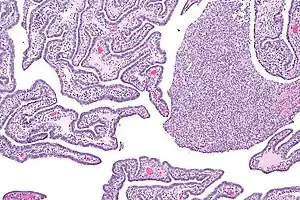Salpingitis
| Salpingitis | |
|---|---|
 | |
| Micrograph of acute and chronic salpingitis. H&E stain. | |
| Specialty | Gynecology |
Salpingitis is an infection and inflammation in the Fallopian tubes (salpinges). It is often used synonymously with pelvic inflammatory disease (PID), although PID lacks an accurate definition and can refer to several diseases of the female upper genital tract, such as endometritis, oophoritis, myometritis, parametritis and infection in the pelvic peritoneum.[1] In contrast, salpingitis only refers to infection and inflammation in the fallopian tubes.[1]
Signs and symptoms
The symptoms usually appear after a menstrual period. The most common are:[2]
- Abnormal smell and colour of vaginal discharge
- Pain during ovulation
- Pain during sexual intercourse
- Pain coming and going during periods
- Abdominal pain
- Lower back pain
- Fever
- Nausea
- Vomiting
- Bloating
Causes
The infection usually has its origin in the vagina and ascends to the Fallopian tube from there. Because the infection can spread via the lymph vessels, infection in one Fallopian tube usually leads to infection of the other.[2]
Risk factors
It's been theorized that retrograde menstrual flow and the cervix opening during menstruation allows the infection to reach the Fallopian tubes.
Other risk factors include surgical procedures that break the cervical barrier, such as:
- endometrial biopsy
- curettage
- hysteroscopy[1]
Another risk is factors that alter the microenvironment in the vagina and cervix, allowing infecting organisms to proliferate and eventually ascend to the Fallopian tube:
- antibiotic treatment
- ovulation
- menstruation
- sexually transmitted disease (STD)
Finally, sexual intercourse may facilitate the spread of disease from the vagina to the Fallopian tube. Coital risk factors are:
- Uterine contractions
- Sperm, carrying organisms upward
Bacterial species
The bacteria most associated with salpingitis are:
However, salpingitis is usually polymicrobial, involving many kinds of organisms. Other examples of organisms involved are:
- Ureaplasma urealyticum
- Anaerobic and aerobic bacteria
Diagnosis
Salpingitis may be diagnosed by pelvic examination, blood tests, and/or a vaginal or cervical swab.
Acute and chronic salpingitis
There are two types of salpingitis: acute salpingitis and chronic salpingitis.
Epidemiology
Over one million cases of acute salpingitis are reported every year in the US, but the number of incidents is probably larger, due to incomplete and untimely reporting methods and that many cases are reported first when the illness has gone so far that it has developed chronic complications. For women age 16–25, salpingitis is the most common serious infection. It affects approximately 11% of females of reproductive age.[1]
Salpingitis has a higher incidence among members of lower socioeconomic classes. However, this is thought of being an effect of earlier sex debut, multiple partners, and decreased ability to receive proper health care rather than any independent risk factor for salpingitis.
As an effect of an increased risk due to multiple partners, the prevalence of salpingitis is highest for people age 15–24 years. Decreased awareness of symptoms and less will to use contraceptives are also common in this group, raising the occurrence of salpingitis.
Complications
For the affected, 20% need hospitalization. Regarding patients age 15–44 years, 0.29 per 100,000 dies from salpingitis.[1]
However, salpingitis can also lead to infertility because the eggs released in ovulation can't get contact with the sperm. Approximately 75,000-225,000 cases of infertility in the US are caused by salpingitis. The more times one has the infection, the greater the risk of infertility. With one episode of salpingitis, the risk of infertility is 8-17%. With 3 episodes of salpingitis, the risk is 40-60%, although the exact risk depends on the severity of each episode.[1]
In addition, damaged oviducts increase the risk of ectopic pregnancy. Thus, if one has had salpingitis, the risk of a pregnancy to become ectopic is 7 to 10-fold as large. Half of ectopic pregnancies are due to a salpingitis infection.[1]
Other complications are:[2]
- Infection of ovaries and uterus
- Infection of sex partners
- An abscess on the ovary
Treatment
Salpingitis is most commonly treated with antibiotics.[2]